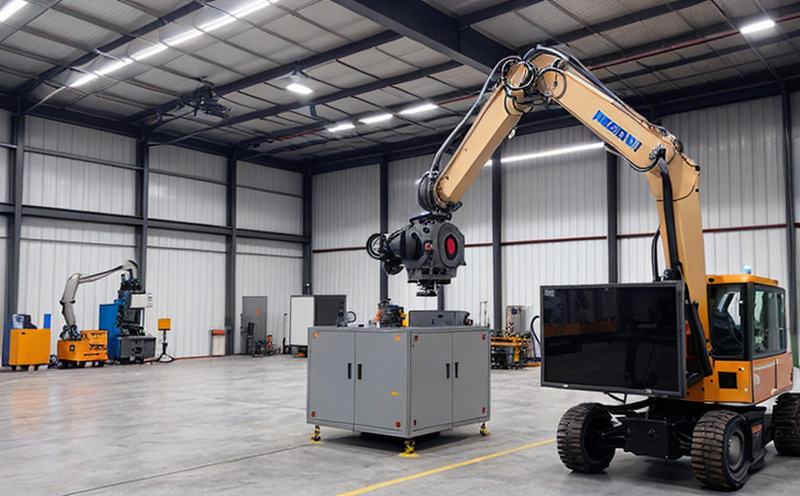ISO 18646 Performance Testing of Service and Industrial Robots
The ISO 18646 standard provides a framework for testing the performance of service and industrial robots. This standard is particularly relevant in sectors such as manufacturing, logistics, and healthcare, where precision and reliability are paramount. The test ensures that robots meet their design specifications under various operating conditions, thus enhancing safety and operational efficiency.
ISO 18646 involves a series of performance tests aimed at evaluating key parameters including accuracy, repeatability, speed, payload capacity, and endurance. These tests are conducted in controlled environments to simulate real-world scenarios. The primary objective is to ensure that robots operate within specified tolerances and meet the stringent requirements set by industry standards.
Testing begins with a thorough inspection of the robot's mechanical components, electrical systems, and software. This includes verifying the robot’s structural integrity, joint configurations, and control system capabilities. Once these initial checks are completed, the robot undergoes performance tests using ISO 18646 protocols. These tests can involve complex maneuvers such as picking up objects, navigating through obstacles, and performing repetitive tasks.
The accuracy of a robot is crucial for its application in delicate operations like surgery or precision manufacturing. Repeatability ensures that the robot performs the same task consistently, which is essential for quality assurance in production lines. Speed is another critical parameter as it directly impacts productivity. Payload capacity determines whether the robot can handle specific tasks without compromising on performance.
Endurance tests assess how long a robot can operate continuously before requiring maintenance or replacement of components. This aspect is vital for ensuring that robots function reliably over extended periods, especially in environments where continuous operation is necessary. The test results are meticulously recorded and analyzed to provide comprehensive reports that highlight any deviations from expected performance.
Compliance with ISO 18646 not only ensures the reliability of industrial robots but also enhances safety by identifying potential hazards early on. This compliance can lead to cost savings in terms of reduced downtime, lower maintenance costs, and improved worker safety. In sectors like healthcare, where precision is critical, adherence to this standard ensures that robotic systems operate flawlessly, thereby enhancing patient care.
The testing process also involves simulating various environmental conditions such as temperature fluctuations, humidity levels, and electromagnetic interference. These simulations help in understanding how the robot behaves under non-ideal circumstances, which is crucial for ensuring robust performance across diverse operational environments.
Accurate reporting of test results provides valuable insights into a robot’s capabilities and limitations. This information is invaluable for R&D teams looking to refine existing models or develop new ones. By leveraging these reports, manufacturers can make informed decisions about product improvements, thereby staying competitive in the market.
Why Choose This Test
- Enhanced Safety: Ensures compliance with international standards and identifies potential hazards early on.
- Increased Reliability: Guarantees consistent performance across all operating conditions, enhancing productivity.
- Precise Performance Evaluation: Provides a comprehensive assessment of key parameters like accuracy, repeatability, speed, payload capacity, and endurance.
- Cost Efficiency: Reduces downtime by identifying issues early on, leading to lower maintenance costs.
- Improved Worker Safety: By ensuring that robots operate within specified tolerances, this test minimizes risks associated with robotic operations.
- Compliance Assurance: Demonstrates adherence to international standards, which is crucial for regulatory compliance and market entry in specific regions.
Environmental and Sustainability Contributions
The ISO 18646 performance testing of service and industrial robots contributes significantly to environmental sustainability by ensuring that these robotic systems operate efficiently with minimal waste. By conducting rigorous tests, manufacturers can optimize robot designs for better energy consumption, which in turn reduces the overall carbon footprint associated with their operations.
Moreover, this testing ensures that robots are robust enough to perform their tasks over extended periods without frequent replacements or repairs. This longevity not only extends the lifecycle of these systems but also reduces electronic waste generated through frequent disposals and replacements. Additionally, by ensuring precise performance, ISO 18646 helps in optimizing resource usage, leading to more sustainable manufacturing processes.
The testing process itself is conducted with a focus on minimizing environmental impact. This includes using energy-efficient test equipment and ensuring that all materials used during the tests are recyclable or environmentally friendly. By adhering to these practices, laboratories involved in ISO 18646 compliance contribute positively to sustainable development goals.
Furthermore, the insights gained from this testing can be leveraged by manufacturers to develop more eco-friendly robotic systems. This includes designing robots that require less energy for operation and using materials that are easier to recycle at the end of their lifecycle. Such advancements not only benefit the environment but also contribute to a more sustainable future.
Use Cases and Application Examples
| Use Case | Description |
|---|---|
| Manufacturing | In this sector, ISO 18646 performance testing ensures that robots can handle repetitive tasks with precision and efficiency. This is crucial for maintaining product quality and reducing errors. |
| Logistics | For warehouse and distribution centers, the test guarantees that robots can navigate through complex environments efficiently, improving supply chain management. |
| Healthcare | In hospitals, this testing ensures that robotic systems used in surgeries or rehabilitation processes are reliable and safe. It enhances patient care by minimizing risks associated with robotic interventions. |
| Automotive | The test helps automotive manufacturers ensure that robots can perform tasks like welding, painting, and assembly accurately and consistently, contributing to high-quality vehicle production. |
| Application Example | Description |
|---|---|
| Automated Warehouse Systems | A system that uses ISO 18646 compliant robots can significantly enhance warehouse efficiency by automating inventory management and order fulfillment processes. |
| Surgical Robots | In healthcare, these robots are used to perform minimally invasive surgeries with greater precision than traditional methods. Testing ensures their reliability for such critical applications. |
| Robotic Paint Spraying | In automotive manufacturing, robotic arms coated in ISO 18646 tests ensure that paint sprays adhere uniformly and consistently, resulting in high-quality finishes. |





